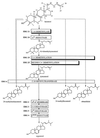A yeast sterol auxotroph (erg25) is rescued by addition of azole antifungals and reduced levels of heme
- PMID: 9326581
- PMCID: PMC23406
- DOI: 10.1073/pnas.94.21.11173
A yeast sterol auxotroph (erg25) is rescued by addition of azole antifungals and reduced levels of heme
Abstract
Genetic disruption of the Saccharomyces cerevisiae C-4 sterol methyl oxidase ERG25 gene leads to sterol auxotrophy. We have characterized a suppression system that requires two mutations to restore viability to this disrupted strain. One suppressor mutation is erg11, which is blocked in 14alpha-demethylation of lanosterol and is itself an auxotroph. The second suppressor mutation required is either slu1 or slu2 (suppressor of lanosterol utilization). These mutations are leaky versions of HEM2 and HEM4, respectively; addition of exogenous hemin reverses the suppressing effects of slu1 and slu2. Suppression of erg25 by erg11 slu1 (or erg11 slu2) results in a slow-growing strain in which lanosterol, the first sterol in the pathway, accumulates. This result indicates that endogenously synthesized lanosterol can substitute for ergosterol and support growth. In the triple mutants, all but 1 (ERG6) of the 13 subsequent reactions of the ergosterol pathway are inactive. Azole antibiotics (clotrimazole, ketoconazole, and itraconazole) widely used to combat fungal infections are known to do so by inhibiting the ERG11 gene product, the 14alpha-demethylase. In this investigation, we demonstrate that treatment of the sterol auxotrophs erg25 slu1 or erg25 slu2 with azole antibiotics paradoxically restores viability to these strains in the absence of sterol supplementation via the suppression system we have described.
Figures






References
-
- Lees N D, Bard M, Kirsch D R. In: Biochemistry and Function of Sterols. Parish E J, Nes W D, editors; Parish E J, Nes W D, editors. Boca Raton, FL: CRC; 1997. pp. 85–99.
-
- Lees N D, Skaggs B, Kirsch D R, Bard M. Lipids. 1995;30:221–226. - PubMed
-
- Vanden Bossche H, Willemsens G, Marichal P. Crit Rev Microbiol. 1987;15:57–72. - PubMed
-
- Georgopapadakou N H, Walsh T J. Science. 1994;264:371–373. - PubMed
-
- Hitchcock C A. Biochem Soc Trans. 1993;21:1039–1047. - PubMed
Publication types
MeSH terms
Substances
Grants and funding
LinkOut - more resources
Full Text Sources
Other Literature Sources
Molecular Biology Databases
Miscellaneous

